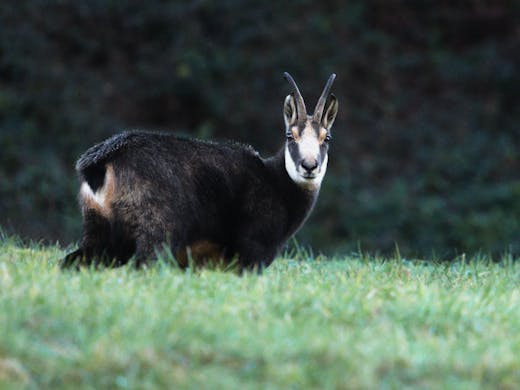Impressions in Switzerland
I have been a regular visitor to Switzerland, often exploring its picturesque landscapes. In this article, I present a collection of photos and impressions from my latest journey. Among them is a captivating snapshot of the Red Kite, a prevalent raptor native to the Swiss midlands.
Farewell Gift from Switzerland - Red Kite

On my last hike along the valley of the Glarnerland, I got close enough to take some shots of a gliding Red Kite, circling over fields still not snow covered.
It is always of great joy to spot this medium sized bird of prey. It isn’t a rare observation though where I stayed while in Switzerland. I saw this species almost every day, even while visiting shortly Sargans.
Taking a good photo of this bird is more challenging though. Usually, they circle very high and fly away if I am standing on the open field. In this case, I was located at a slope adjacent to a grass field, not being seen by the bird until the bird flew over the crest. Luckily, this time my camera setting have been correct for taking a photo of a bird in flight.
About Red Kite (Milvus milvus)
Rotmilan (de), Red Kite (en), Milano real (es), Milan royal (fr)
The red kite is a medium-large bird of prey in the family Accipitridae. The species currently breeds in the Western Palearctic region of Europe and northwest Africa.
More Info: Wikipedia
A Mountain near Glarus - Vorder Glärnisch

During the first days of my Christmas family visit in Switzerland, it was mostly rainy at lower altitude but the nearby mountains had their beautiful powdered sugar decoration contrasting with the trees and forests.
I use Affinity Photo† to edit my photos. In RAW persona, I modify exposure (moving histogram, more centric) and noise reduction. In photo persona, I usually apply curves, HSL adjustment and at the end sharpening with high pass filter.
With this particular shot, I additionally reduced saturation on the blue channel turning it nearly B&W, brightness/contrast to improve structure within clouds and shadows/highlights adjustments for the forest.
Balance Act of an Eurasian Coot - Taucherli

Eurasian coot, called "Taucherli" in Swiss german, is a common bird in many lakes of Switzerland.
Rarely visiting my home country Switzerland has the advantage that even very common birds like the Eurasian coot was a new species for my photo collection. I combined the visit of my parents with a stroll along the upper shores of Walensee where I spotted many Eurasian coots, Black-headed gulls and a few Mute swans.
Coots are not that shy, so that with some care you can get close for taking photos without the need to attract them with food. I never feed wild animals.
Unfortunately, the sunlight was strong and direct so that these black birds look like light grey and their white-pink beak and white facial shield may have been overexposed. At least, I was able to get around the birds having the sun in my back.
About Eurasian Coot (Fulica atra)
Blässhuhn (de), Eurasian coot (en), Focha común (es), Foulque macroule (fr)
The Eurasian coot (Fulica atra), also known as the common coot, or Australian coot, is a member of the rail and crake bird family. It is found in Europe, Asia, Australia, New Zealand and parts of Africa.
More Info: Wikipedia
Spotting a Chamois - Gämse, Chamois, Gamuza

After several intents, I finally managed to get a decent shot of a wild chamois in the Swiss alps.
Before, I went up to the mountains during summer months looking out for chamois and found a few but always too far away within impassable vegetation or above rocks. In winter, these animals go down to the valley to feed. I changed my strategy and visited Switzerland in winter in hope to spot one and being able to get close enough.
Light wasn’t the best, the animal was grazing in the shadow near the forest. Further, not helpful that I messed up shutter speed. I still had the setting from the previous bird shooting and didn’t dialed down to 1/640 or 1/320 for the much slower chamois.
I use to shoot with manual setting for focus, aperture and shutter speed but rely on auto iso when I expect not having time to review shots and adjust iso which is usually the case with random encounters during hikes.
About Chamois (Rupicapra rupicapra)
Gämse (de), Chamois (en, fr), Gamuza (es)
The chamois (Rupicapra rupicapra) is a species of goat-like native to Europe and Asia Minor. Together with the Pyrenees chamois and other species, it belongs to the chamois genus (Rupicapra).
More Info: Wikipedia
We need your help! By making a contribution towards our hosting costs, you can help us provide an ad-free experience on our website in the near future. Paypal
